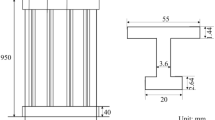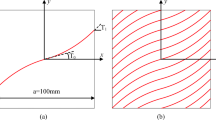Abstract
Variable-stiffness panel is very promising for the cutout reinforcement of composite structures. However, due to the increase of design variables, the optimization of variable-stiffness panels becomes very challenging, even if surrogate model is utilized, because the fidelity of surrogate model is difficult to guarantee for high-dimensional problems. In this study, isogeometric analysis method (IGA) is employed to predict the buckling load of variable-stiffness panels, which can produce accurate prediction with less computational cost compared to traditional FEA, moreover, it can provide analytical sensitivity for optimization. On this basis, an adaptive gradient-enhanced kriging (GEK) model assisted by a novel multiple points infilling criterion is constructed for the global optimization of variable-stiffness composite panels. The proposed method is compared with traditional surrogate model, and results show that the proposed method can find a better optimum design in a more efficient manner. It can be concluded that the proposed method is able to fully explore the advantages of IGA including exact modelling, analysis and analytical sensitivity, which is particularly suitable for the design of variable-stiffness panels and other complex structures.
















Similar content being viewed by others
References
Abouhamze M, Shakeri M (2007) Multi-objective stacking sequence optimization of laminated cylindrical panels using a genetic algorithm and neural networks. Compos Struct 81(2):253–263
Blom AW, Tatting BF, Hol JMAM (2009) Fiber path definitions for elastically tailored conical shells. Compos Part B Eng 40(1):77–84
Bourada F, Amara K, Tounsi A (2016) Buckling analysis of isotropic and orthotropic plates using a novel four variable refined plate theory. Steel Compos Struct 21(6):1287–1306
Brampton CJ, Wu KC, Kim HA (2015) New optimization method for steered fiber composites using the level set method. Struct Multidiscip O 52(3):493–505
Chung HS, Alonso J (2002) Using gradients to construct cokriging approximation models for high-dimensional design optimization problems. AIAA paper 317:2002
Gürdal Z, Tatting BF, Wu CK (2008) Variable stiffness composite panels: effects of stiffness variation on the in-plane and buckling response. Compos Part A-Appl S 39(5):911–922
Haftka RT, Villanueva D, Chaudhuri A (2016) Parallel surrogate-assisted global optimization with expensive functions–a survey. Struct Multidiscip O 54(1):3–13
Han ZH, Görtz S (2012) Hierarchical kriging model for variable-fidelity surrogate modeling. AIAA J 50(9):1885–1896
Hao P, Wang B, Li G (2012) Surrogate-based optimum design for stiffened shells with adaptive sampling. AIAA J 50(11):2389–2407
Hao P, Wang B, Li G, Tian K, Du KF, Wang XJ, Tang XH (2013) Surrogate-based optimization of stiffened shells including load-carrying capacity and imperfection sensitivity. Thin-Walled Struct 72(15):164–174
Hao P, Wang B, Tian K, Li G, Zhang X (2016a) Optimization of curvilinearly stiffened panels with single cutout concerning the collapse load. Int J Struct Stab Dy 16:1550036–1–1550036–21
Hao P, Wang B, Du KF, Li G, Tian K, Sun Y, Ma YL (2016b) Imperfection-insensitive design of stiffened conical shells based on perturbation load approach. Compos Struct 136:405–413
Hao P, Yuan XJ, Liu HL, Wang B, Liu C, Yang DX, Zhan SX (2017a) Isogeometric buckling analysis of composite variable-stiffness panels. Compos Struct 165:192–208
Hao P, Wang YT, Liu C, Wang B (2017b) A novel non-probabilistic reliability-based design optimization algorithm using enhanced chaos control method. Comput Method Appl M 318:572–593
Huang D, Allen TT, Notz WI (2006) Global optimization of stochastic black-box systems via sequential kriging meta-models. J Glob Optim 34(3):441–466
Huang G, Wang H, Li G (2016) An efficient reanalysis assisted optimization for variable-stiffness composite design by using path functions. Compos Struct 153:409–420
Hughes TJR, Cottrell JA, Bazilevs Y (2005) Isogeometric analysis: CAD, finite elements, NURBS, exact geometry and mesh refinement. Comput Methods Appl Mech Eng 194(39):4135–4195
Jing Z, Fan XL, Sun Q (2015) Global shared-layer blending method for stacking sequence optimization design and blending of composite structures. Compos B: Eng 69:181–190
Jing Z, Sun Q, Silberschmidt VV (2016) A framework for design and optimization of tapered composite structures part I: from individual panel to global blending structure. Compos Struct 154:106–128
Jones DR, Schonlau M, Welch WJ (1998) Efficient global optimization of expensive black-box functions. J Glob Optim 13(4):455–492
Kahya V (2016) Buckling analysis of laminated composite and sandwich beams by the finite element method. Compos Part B Eng 91:126–134
Karakaya Ş, Soykasap Ö (2009) Buckling optimization of laminated composite plates using genetic algorithm and generalized pattern search algorithm. Struct Multidiscip O 39(5):477–486
Kristinsdottir BP, Zabinsky ZB, Tuttle ME (2001) Optimal design of large composite panels with varying loads. Compos Struct 51(1):93–102
Laurenceau J, Sagaut P (2008) Building efficient response surfaces of aerodynamic functions with kriging and cokriging. AIAA J 46(2):498
Laurent L, Boucard PA, Soulier B (2013) Generation of a cokriging metamodel using a multiparametric strategy. Comput Mech 51(2):151–169
Le Riche R, Haftka RT (1993) Optimization of laminate stacking sequence for buckling load maximization by genetic algorithm. AIAA J 31(5):951–956
Li Z, Ruan S, Gu J (2016) Investigation on parallel algorithms in efficient global optimization based on multiple points infill criterion and domain decomposition. Struct Multidiscip O 54(4):747–773
Liu W, Batill SM (2002) Gradient-enhanced response surface approximations using kriging models. AIAA/ISSMO S EXH M: 4–6
Liu B, Haftka RT, Akgün MA (2000) Permutation genetic algorithm for stacking sequence design of composite laminates. Comput Method Appl M 186(2):357–372
Liu D, Toropov VV, Querin OM (2011) Bilevel optimization of blended composite wing panels. J Aircr 48(1):107
Lozano GG, Tiwari A, Turner C (2016) A review on design for manufacture of variable stiffness composite laminates. P I Mech Eng B 230(6):981–992
Madeo A, Groh RMJ, Zucco G (2017) Post-buckling analysis of variable-angle tow composite plates using Koiter's approach and the finite element method. Thin-Walled Struct 110:1–13
Montemurro M, Catapano A (2017) On the effective integration of manufacturability constraints within the multi-scale methodology for designing variable angle-tow laminates. Compos Struct 161:145–159
Morris MD, Mitchell TJ, Ylvisaker D (1993) Bayesian design and analysis of computer experiments: use of derivatives in surface prediction. Technometrics 35(3):243–255
Muc A, Ulatowska A (2010) Design of plates with curved fiber format. Compos Struct 92(7):1728–1733
Nik MA, Fayazbakhsh K, Pasini D (2014) A comparative study of metamodeling methods for the design optimization of variable stiffness composites. Compos Struct 107:494–501
Niu XJ, Yang T, Du Y (2016) Tensile properties of variable stiffness composite laminates with circular holes based on potential flow functions. Arch Appl Mech 86(9):1551–1563
Peeters DMJ, Hesse S, Abdalla MM (2015) Stacking sequence optimisation of variable stiffness laminates with manufacturing constraints. Compos Struct 125:596–604
Rehman SU, Langelaar M, Keulen FV (2014) Efficient kriging-based robust optimization of unconstrained problems. J Comput Sci 5(6):872–881
Rikards R, Abramovich H, Auzins J (2004) Surrogate models for optimum design of stiffened composite shells. Compos Struct 63(2):243–251
Rouhi M, Ghayoor H, Hoa SV (2017) Computational efficiency and accuracy of multi-step design optimization method for variable stiffness composite structures. Thin-Walled Struct 113:136–143
Sasena MJ, Papalambros P, Goovaerts P (2002) Exploration of metamodeling sampling criteria for constrained global optimization. Eng Optim 34(3):263–278
Sóbester A, Leary SJ, Keane AJ (2005) On the design of optimization strategies based on global response surface approximation models. J Glob Optim 33(1):31–59
Soremekun G, Gürdal Z, Haftka RT (2001) Composite laminate design optimization by genetic algorithm with generalized elitist selection. Comput Struct 79(2):131–143
Sørensen SN, Lund E (2013) Topology and thickness optimization of laminated composites including manufacturing constraints. Struct Multidiscip O 48(2):249–265
Todoroki A, Sekishiro M (2008) Modified efficient global optimization for a hat-stiffened composite panel with buckling constraint. AIAA J 46(9):2257
Ulaganathan S, Couckuyt I, Ferranti F (2015) Performance study of multi-fidelity gradient enhanced kriging. Struct Multidiscip O 51(5):1017–1033
Van den Brink WM, Vankan WJ, Maas R (2012) Buckling optimized variable stiffness laminates for a composite fuselage window section. Int C Aer SCI B
Viana FAC, Haftka RT, Watson LT (2013) Efficient global optimization algorithm assisted by multiple surrogate techniques. J Glob Optim 56(2):669–689
Wang P, Costin DP (1992) Optimum design of a composite structure with three types of manufacturing constraints. AIAA J 30(6):1667–1669
Wang K, Kelly D, Dutton S (2002) Multi-objective optimisation of composite aerospace structures. Compout Struct 57(1):141–148
Wang B, Hao P, Li G et al (2014) Two-stage size-layout optimization of axially compressed stiffened panels. Struct Multidiscip O 50(2):313–327
Wu Z, Raju G, Weaver PM (2015) Framework for the buckling optimization of variable-angle tow composite plates. AIAA J 53(12):3788–3804
Yamazaki W, Mavriplis DJ (2013) Derivative-enhanced variable fidelity surrogate modeling for aerodynamic functions. AIAA J 51(1):126–137
Yamazaki W, Rumpfkeil MP, Mavriplis DJ (2010) Design optimization utilizing gradient/hessian enhanced surrogate model. 20104363 AIAA
Zehnder N, Ermanni P (2006) A methodology for the global optimization of laminated composite structures. Compos Struct 72(3):311–320
Zhu JH, Zhang WH, Xia L (2016) Topology optimization in aircraft and aerospace structures design. Arch Comput Method E 23(4):595–622
Acknowledgements
This work was supported by the National Natural Science Foundation of China (11772078), the Young Elite Scientists Sponsorship Program by CAST (2017QNRC001), the National Basic Research Program of China (2014CB049000 and 2014CB046506), the Fundamental Research Funds for Central University of China (DUT2013TB03 and DUT17GF102).
Author information
Authors and Affiliations
Corresponding authors
Additional information
Responsible Editor: Hai Huang
Appendix
Appendix
The predicted function of GEK can be written as
where ω i denotes the weight coefficient of the ith response value, and \( {\nu}_j^i \) denotes the weight coefficient the partial derivative of the jth dimensional design variable to the ith response value. The regression function is defined as
So far, the weight coefficients can be calculated by solving the minimization problem about MSE(x) with the Lagrange multiplier approach. It can be found as follows
And μ is the Lagrange multipliers.
Also, (35) can be written as a matrix function
where
The correlation vector and the correlation matrix can be expressed as
The predicted MSE of \( \widehat{y}(x) \) is
As both \( \widehat{y}(x) \) and MSE are the functions of σ2 and θ, θ can be calculated by the maximum likelihood estimation approach. \( \widehat{y}(x) \) follows the multidimensional normal distribution as
Take the partial derivative with respect to σ2 of this equation and let it zero, σ2 and β can be obtained as
Rights and permissions
About this article
Cite this article
Hao, P., Feng, S., Zhang, K. et al. Adaptive gradient-enhanced kriging model for variable-stiffness composite panels using Isogeometric analysis. Struct Multidisc Optim 58, 1–16 (2018). https://doi.org/10.1007/s00158-018-1988-1
Received:
Revised:
Accepted:
Published:
Issue Date:
DOI: https://doi.org/10.1007/s00158-018-1988-1




